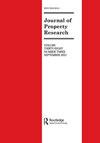AR-GARCH-EVT-Copula for securitised real estate: an approach to improving risk forecasts?
IF 2.3
Q2 URBAN STUDIES
引用次数: 0
Abstract
ABSTRACT This study presents a quantitative analysis of the so-called AR-GARCH-EVT-Copula model aimed at forecasting risk metrics for multi-asset portfolios, including securitised real estate positions. The model incorporates a non-linear dependence structure and time-varying volatility in asset returns. Accordingly, an empirical study using data from six major global markets is carried out. The approach is applied to forecast risk metrics, in comparison to classical methods like historical simulation and variance-covariance models. Forecasts are then compared with realised returns, to calculate hit sequences and conduct statistical interference on the respective models. It is empirically shown that, the AR-GARCH-EVT-Copula model provides a superior forecast concerning risk metrics. This is mainly due to the usage of copulas, allowing us to individually model the dependence structure of random variables. Back testing and test results confirm the superiority of our model in comparison with classic methods such as historical simulation and Variance-Covariance approach. The decomposition of the univariate and multivariate models of the target model reveal the necessity to allow for high order and thus long-lasting autoregressive modelling as well as asymmetric tail dependence and rotated copulae across different portfolios.房地产证券化的AR-GARCH-EVT-Copula:一种改进风险预测的方法?
摘要本研究对所谓的AR GARCH EVT Copula模型进行了定量分析,旨在预测包括证券化房地产头寸在内的多资产投资组合的风险指标。该模型包含了资产回报的非线性依赖结构和时变波动性。因此,使用来自全球六个主要市场的数据进行了一项实证研究。与历史模拟和方差-协方差模型等经典方法相比,该方法被应用于预测风险指标。然后将预测与实现的回报进行比较,以计算命中序列并对相应的模型进行统计干扰。经验表明,AR-GARCH-EVT-Copula模型在风险度量方面提供了优越的预测。这主要是由于使用了copula,使我们能够对随机变量的依赖结构进行单独建模。回测和测试结果证实了我们的模型与历史模拟和方差协方差方法等经典方法相比的优越性。目标模型的单变量和多变量模型的分解揭示了允许高阶从而持久的自回归建模的必要性,以及不同投资组合的不对称尾部依赖性和旋转Copula。
本文章由计算机程序翻译,如有差异,请以英文原文为准。
求助全文
约1分钟内获得全文
求助全文
来源期刊

Journal of Property Research
URBAN STUDIES-
CiteScore
3.80
自引率
5.30%
发文量
13
期刊介绍:
The Journal of Property Research is an international journal. The title reflects the expansion of research, particularly applied research, into property investment and development. The Journal of Property Research publishes papers in any area of real estate investment and development. These may be theoretical, empirical, case studies or critical literature surveys.
 求助内容:
求助内容: 应助结果提醒方式:
应助结果提醒方式:


